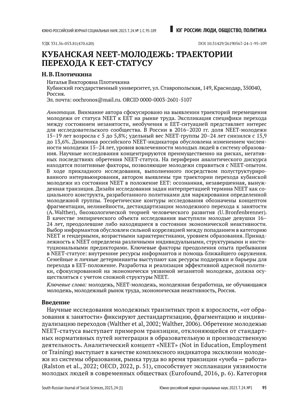Аннотация
Внимание автора сфокусировано на выявлении траекторий перемещения молодежи от статуса NEET к EET на рынке труда. Экспликация специфики перехода между состоянием незанятости, необучения и EET-ситуацией представляет интерес для исследовательского сообщества. В России в 2016–2020 гг. доля NEET-молодежи 15–19 лет возросла с 5 до 5,8%; удельный вес NEET-группы 20–24 лет снизился с 15,9 до 13,6%. Динамика российского NEET-индикатора обусловлена изменением численности молодежи 15–24 лет, уровня вовлеченности молодых людей в систему образования. Научные исследования концентрируются преимущественно на рисках, негативных последствиях обретения NEET-статуса. На периферии аналитического дискурса находятся позитивные факторы, позволяющие молодежи справиться с NEET-опытом. В ходе прикладного исследования, выполненного посредством полуструктурированного интервьюирования, автором выявлены три траектории перехода кубанской молодежи из состояния NEET в положение EET: осознанная, незавершенная, вынужденная транзиция. Дизайн исследования задан интерпретацией термина NEET как социального конструкта, разработанного политиками для маркирования определенной молодежной группы. Теоретические контуры исследования обозначены концептом фрагментации, нелинейности, дестандартизации молодежного перехода к занятости (A. Walther), биоэкологической теорией человеческого развития (U. Bronfenbrenner). В качестве эмпирического объекта исследования выступили молодые девушки 16–24 лет, преодолевшие либо находящиеся в состоянии экономической неактивности. Выбор информантов обусловлен сильной корреляцией между попаданием в категорию NEET и гендерными, возрастными характеристиками, уровнем образования. Принадлежность к NEET определена различными индивидуальными, структурными и институциональными предикторами. Ключевые факторы преодоления опыта пребывания в NEET-статусе: внутренние ресурсы информантов и помощь ближайшего окружения. Семейные и личные детерминанты выступают как ресурсы поддержки и барьеры для перехода в EET-положение. Разработка и реализация эффективной адресной политики, сфокусированной на экономически уязвимой незанятой молодежи, должна осуществляться с учетом сложной структуры NEET.
Ключевые слова
Библиографические ссылки
Assmann, M. L., Broschinski, S. (2021). Mapping Young NEETs across Europe: Exploring the Institutional Configurations Promoting Youth Disengagement from Education and Employment. JAYS , 4, 95–117. DOI: 10.1007/s43151-021-00040-w
Bronfenbrenner, U. (2001). The Bioecological Theory of Human Development. In U. Bronfenbrenner (Ed.), Making Human Beings Human: Bioecological Perspectives on Human Development (pp. 3–15). Thousand Oaks, CA: Sage Publications Ltd.
Bulanova, M. B., Artamonova, E. A. (2020). NEET-molodezh’: yevropeyskiy kontekst i rossiyskiye realii [The NEET youth: European Context and Russian Realities]. Vestnik RUDN. Seriya: Sotsiologiya [RUDN Journal of Sociology], 20(1), 64–72. DOI: 10.22363/2313-2272-2020-20-1-64-72
Caroleo, F.E., Rocca, A., Neagu, G., & Keranova, D. (2022). NEETs and the Process of Transition from School to the Labor Market: A Comparative Analysis of Italy, Romania, and Bulgaria. Youth & Society , 54(2S), 109S-129S. DOI: 10.1177/ 0044118X211056360
Eurofound (2016). Exploring the diversity of NEETs . Luxembourg: Publications Office of the European Union. Retrieved from https://www.eurofound.europa.eu/publications/report/2016/exploring-the-diversity-of-neets
Eurostat (2022). Statistics on Young People neither in Employment nor in Education or Training. Retrieved from https://ec.europa.eu/eurostat/statistics-explained/index.php?title=Statistics_on_young_ people_ neither_ in_ employment_nor_in_education_or_training
Felaco, C, Parola, A. (2022). Subjective Well-Being and Future Orientation of NEETs: Evidence from the Italian Sample of the European Social Survey. Social Sciences , 11(10), 482. DOI: 10.3390/soc sci11100482
Geraldine A., Crosby A. (2023). To be or not to be NEET? The Complexity of School-to-work Transitions in Brussels. Brussels Studies [Online], 175. Retrieved from http://journals.openedition.org/ brussels/6404. DOI: 10.4000/brussels.6404
Itogi vyborochnogo obsledovaniya rabochey sily [Results of a Sample Labor Force Survey]. Ofitsial’nyy sayt Federal’noy sluzhby gosudarstvennoy statistiki [Official Website of the Federal State Statistics Service]. Retrieved from https://rosstat.gov.ru/compendium/document/13265
Kleif, H. B. (2023). A Typology of Transition Patterns Involving Long-Term NEET Episodes: Accumulation of Risk and Adversity. Youth , 3(1), 170–183. DOI: 10.3390/youth3010012
Lomteva, E. V., Bedareva, L. Yu. (2022). Pokoleniye NEET: obrazovatel’nyye trayektorii i povedeniye molodezhi na rynke truda [Generation NEET: educational trajectories and youth behavior in the labor market]. Materialy ekspertnogo seminara CENO IPEI RANHiGS [Materials of the Expert Seminar of the CLLE IAER RANEPA] . Режим доступа https://ipei.ranepa.ru/ru/sobytiya-ceno/5358-pokolenie-neet-obrazovatelnye-traektorii-i-povedenie-molodezhi-na-rynke-truda-i-vne-ego
Lorinc, M., Ryan, L., D’Angelo, A., Kaye, N. (2020). De-individualising the ‘NEET problem’: An ecological systems analysis. European Educational Research Journal , 19(5), 412–427. DOI: 10.1177/ 1474904119880402
Nardi, B., Lucarelli, C., Talamonti, M., Arimatea, E., Fiori, V. & Moltedo-Perfetti, A. (2015). NEETs versus EETs: an observational study in Italy on the framework of the HEALTH25 European project. Research in Post-Compulsory Education , 20(4), 377–399. DOI: 10.1080/13596748.2015.1081749
OECD (2022). Education at a Glance 2022: OECD Indicators. Paris: OECD Publishing. DOI: 10.1787/3197152b-en
Parola, A., Donsi, L. (2019). Time perspective and employment status: NEET categories as negative predictor of future. Mediterranean Journal of Clinical Psychology , 7(3), 1–20. DOI: 10.6092/ 2282-1619/2019.7.2093
Pesquera Alonso, C., Iniesta Martinez, A., Munoz Sanchez, P. (2022a). Barriers That Keep Vulnerable People as NEETs. Social Sciences , 11(6), 253. DOI: 10.3390/socsci11060253
Pesquera Alonso, C., Munoz Sanchez, P., Iniesta Martinez, A. (2022b). Is there a Uniform NEET Identity in the European Union? International Journal of Adolescence and Youth , 27(1), 207–220. DOI: 10.1080/02673843.2022.2065922
Ralston, K., Everington, D., Feng, Z., & Dibben, C. (2022). Economic Inactivity, Not in Employment, Education or Training (NEET) and Scarring: The Importance of NEET as a Marker of Long-Term Disadvantage. Work, Employment and Society , 36(1), 59–79. DOI: 10.1177/0950017020973 882
Walther, A. (2006). Regimes of Youth Transitions: Choice, Flexibility and Security in Young People’s Experiences across Different European Contexts. YOUNG , 14(2), 119–139. DOI: 10.1177/ 1103308806062737
Walther, A., Moerch-Hejl, G., Bechmann Jensen, T. (2002). Youth Transitions, Youth Policy and Participation — State of the Art Report . YOYO Project Working Paper 1. Retrieved from https://www.iris-egris.de/yoyo/pdf/YoyoWP1StateofArt.pdf
Zudina, A.A. (2018). Dorogi, vedushchiye v NEET: sluchay Rossii [Ways to NEET: The Case of Russia]. Economichesky Zhurnal [HSE Economic Journal], 22(1), 197–227. DOI: 10.17323/1813-8691-2018-22-2-197-227
Zudina, A.A. (2019). “Ne rabotayut i ne uchatsya”: molodezh NEET na rynke truda v Rossii [“They Do Not Work and Do Not Study”: The NEET Youth in the Russian Labor Market]. Mir Rossii [Universe of Russia], 28(1), 140–160. DOI: 10.17323/1811-038X-2019-28-1-140-160


